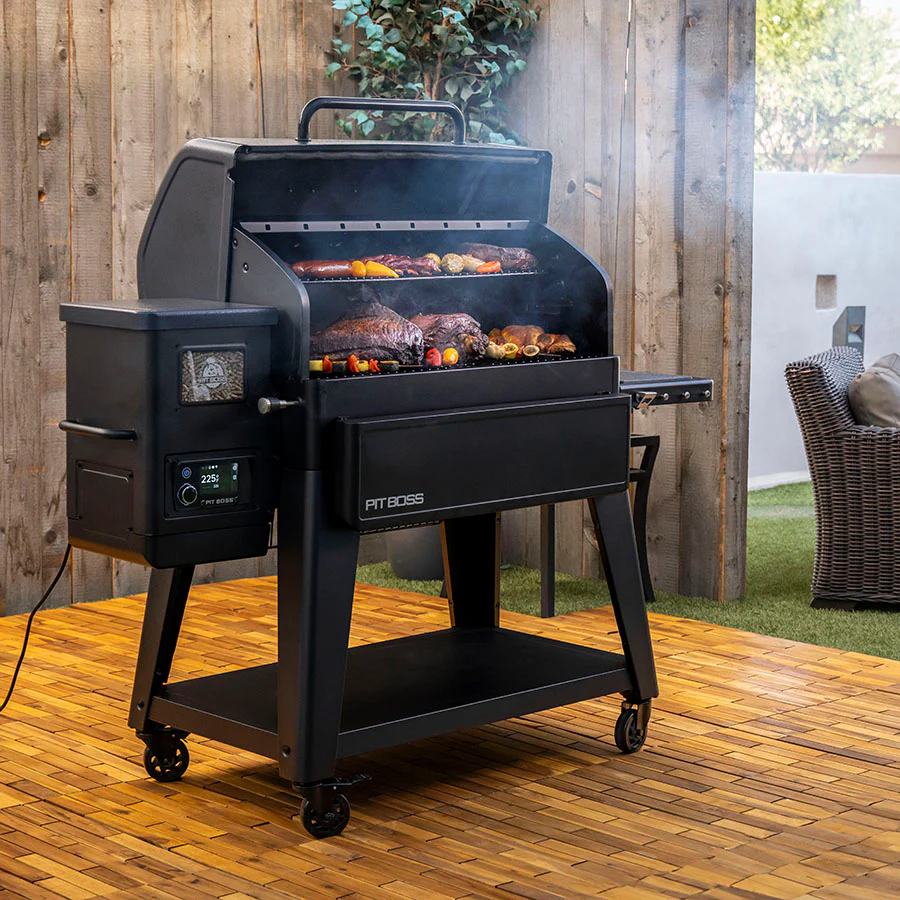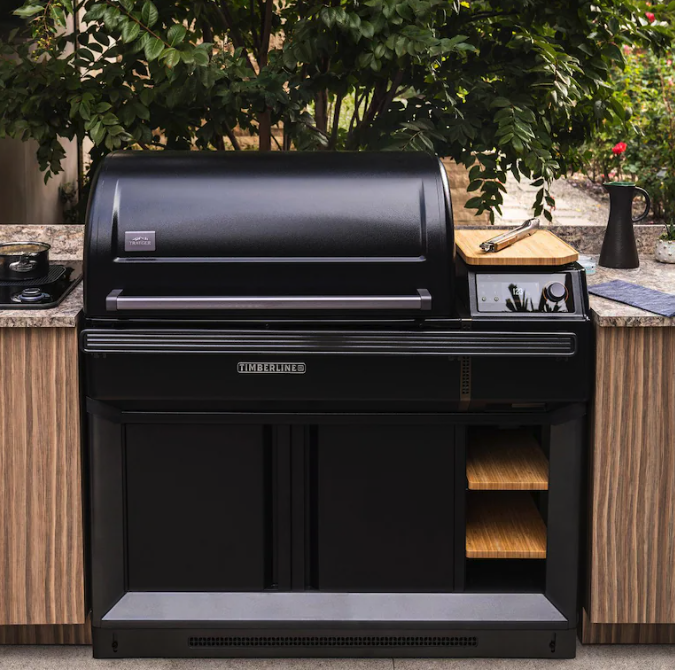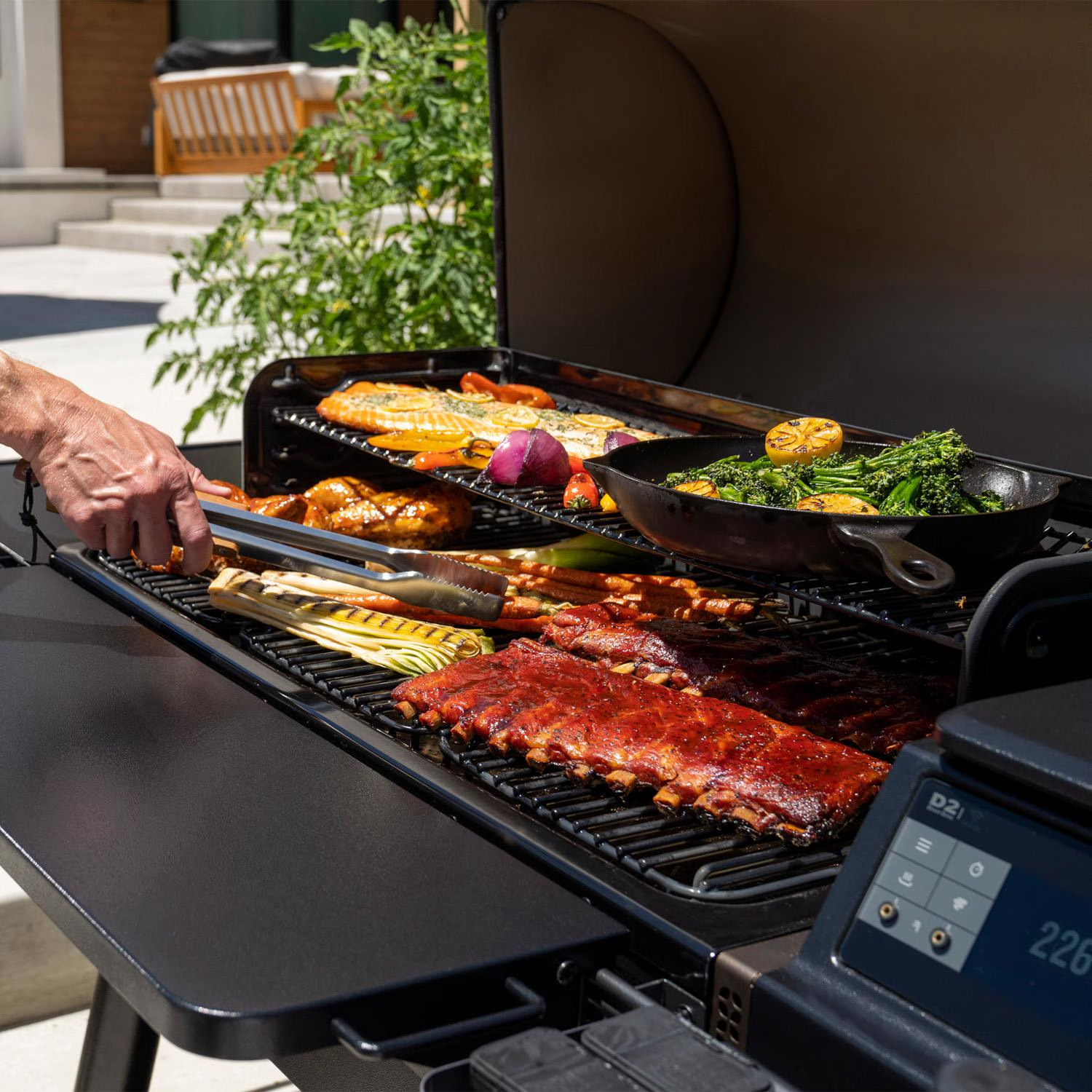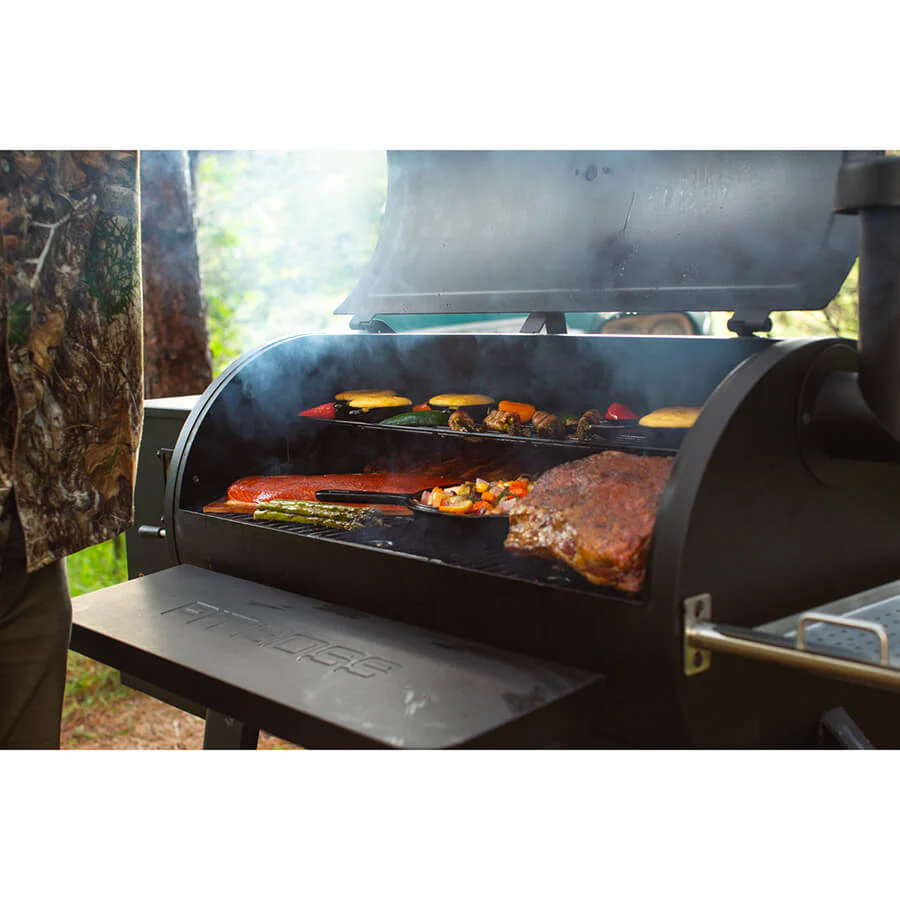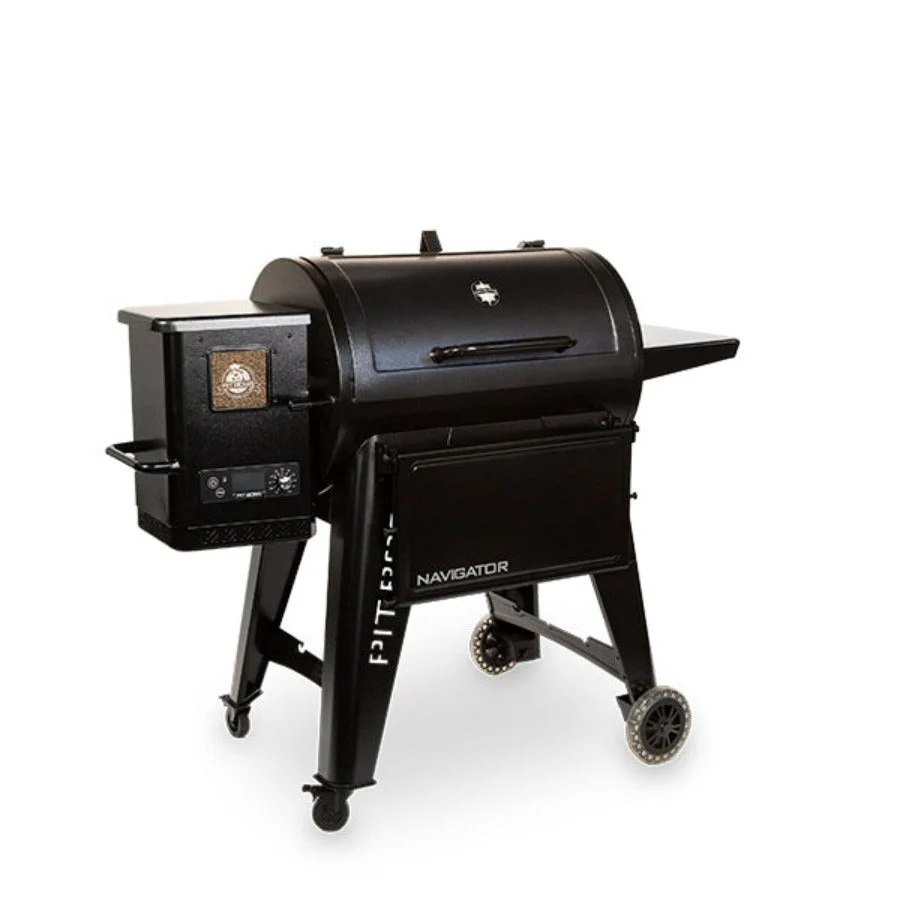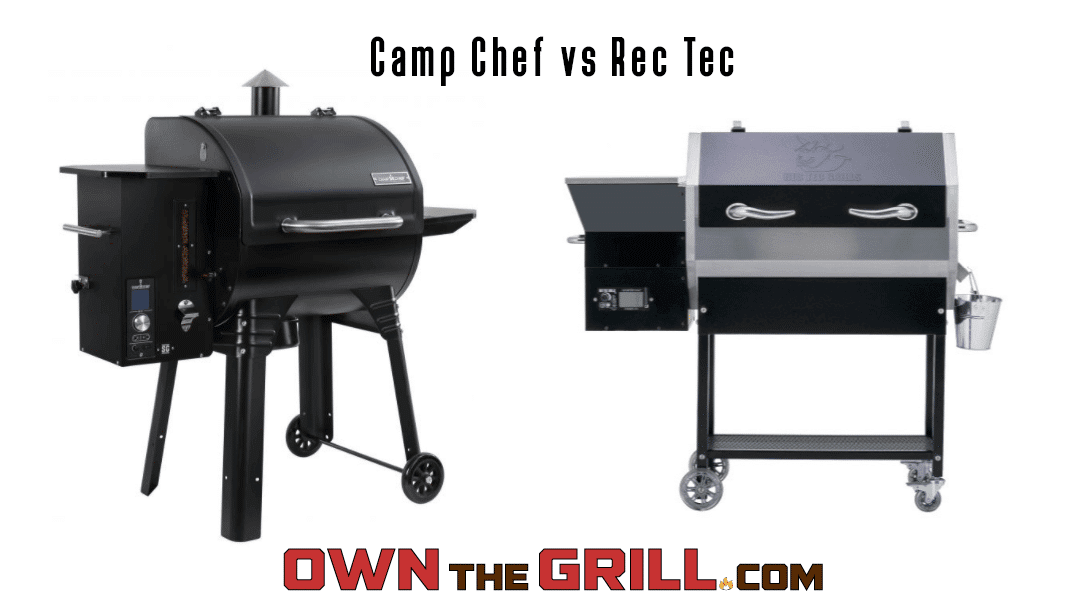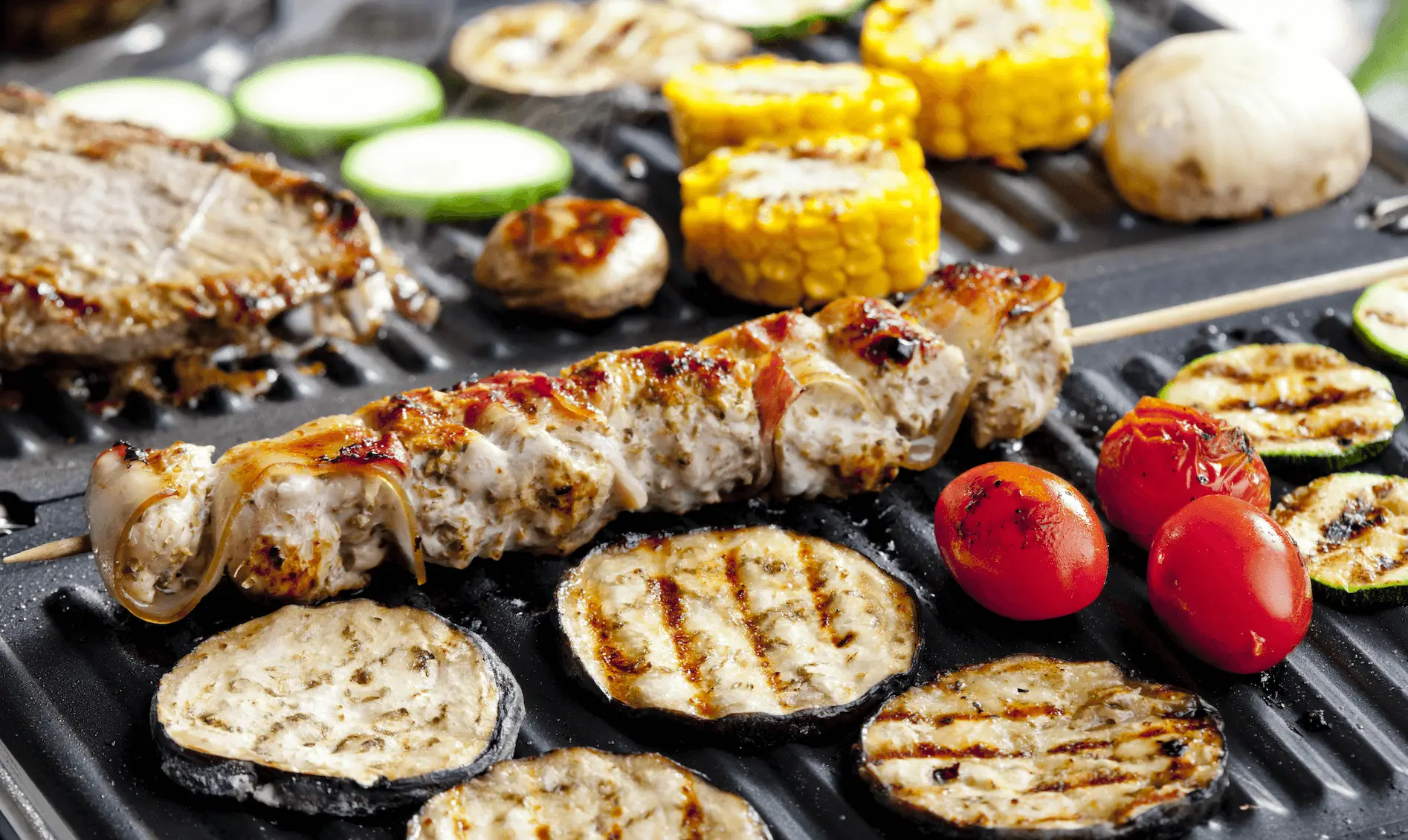If you’re like me, you’ve probably heard the debate about Pit Boss vs Traeger pellet grills. Both brands are giants in the pellet grilling world and offer an easy way to smoke, grill, and sear with wood-fired flavor. But which one is right for you? In this guide, I’ll break down the key differences in a friendly, no-nonsense way, so you can impress your buddies at the next backyard BBQ. Let’s dive in!
Pit Boss and Traeger Overview
Traeger is the original pellet grill pioneer and has built a reputation for premium quality and tech-savvy features. Pit Boss, on the other hand, entered the scene with a focus on value and versatility, often at a lower price point. Both can cook amazing food, but they go about it a little differently:
- Traeger: Known for solid build quality and “set-it-and-forget-it” ease. Traeger grills often include WiFi connectivity (Traeger’s WiFIRE system) and precise digital controllers for steady temperatures. They invented the pellet grill, and their experience shows in the polished design and huge recipe community.
- Pit Boss: Known for bang for your buck. Pit Boss grills typically cost less for a similar size, and they add extras like direct-flame searing capabilities and included shelves. They might not have had as fancy tech in older models, but newer Pit Boss models now offer WiFi and Bluetooth control too. Overall, Pit Boss emphasizes a reasonable cost-to-performance ratio – you get a lot of grill for your money.
Both brands make pellet grills that let you smoke low and slow or crank up the heat to grill. The food that comes off either will have that delicious wood-smoked flavor. The differences come down to features, budget, and how much convenience you want. Let’s compare them in detail across pricing tiers, build quality, smart features, flavor, ease of use, and more.
Pricing and Value: Budget, Mid-Range, and Premium
When it comes to price, Pit Boss generally comes out ahead for value. Pit Boss grills are more affordable on average, with entry-level models starting around $400. Traeger’s lineup tends to start at a higher price point, reflecting their premium branding and features. Here’s how it breaks down by tier:
- Budget Options: If you’re on a tight budget (say, under $600), Pit Boss offers models in that range (for example, smaller Pit Boss pellet grills or older models). Traeger’s lowest-cost full-size grills (like the older Traeger Pro Series 22) still hover around the mid-$600s, and Traeger’s portable or tailgater units are in the high-$400s. In this tier, Pit Boss gives you more cooking space for the money, making it a go-to for budget-conscious buyers.
- Mid-Range ($600–$1000): Both brands compete here, but with different strengths. Take the Pit Boss Navigator 850 (around $749) vs the Traeger Pro 34 (around $729). They’re similarly priced and sized, but the Pit Boss 850 comes with features like a 30 lb hopper (huge pellet capacity) and a Flame Broiler for direct flame searing. The Traeger Pro 34 is a time-tested grill with 884 sq. in. of cooking area and reliable performance, but it lacks WiFi and tops out at 450°F. In newer mid-range models, Traeger introduced the Woodridge Series (starting ~$899) with WiFi and improved design, while Pit Boss has the Sportsman Series 1100 (around $799) which packs in 1,100 sq. in. of base cooking space (expandable to 1,600+ with racks) and also includes WiFi now. In this range, Pit Boss often wins on sheer value – you get a bigger grill with more accessories included (like side shelves, hooks, etc.). Traeger generally wins on tech – the mid-range Traegers have more advanced controllers and a well-loved mobile app.
- Premium ($1,000 and up): Here’s where Traeger really shines, but also costs significantly more. Traeger’s Ironwood XL (around $1,999) and Timberline XL ($3,799) are high-end smart grills loaded with features, from touch-screen controls to pellet sensors and even built-in induction cooktops on the Timberline. They are superbly built and come with extras like double-wall insulation and new accessory mounting systems. Pit Boss’s most expensive models, like the Navigator 1600 ($1,099) and Heritage ($1,299), deliver a ton of cooking area and some advanced features (the Heritage has a 4.3” touchscreen control, stainless steel grates, and even comes with a cover included). However, Pit Boss doesn’t reach Traeger’s ultra-premium price points – even their top model is usually cheaper than Traeger’s Ironwood. If you want the absolute latest innovations (like Traeger’s app integration with recipes, or that induction searing side burner), Traeger’s premium line has it, but you’ll pay for it. For many backyard chefs, Pit Boss’s mid-tier grills provide all the function you need at half the price of a Traeger Timberline.
Bottom line on value: Pit Boss is the best choice for budget-conscious buyers or anyone who wants the most grill for their dollar. Traeger is the choice if you’re willing to invest extra for premium features and a polished user experience. It’s often said that Pit Boss gives better value for the money, while Traeger gives a more high-end experience. Keep your wallet in mind, but also consider the long-term use – either grill will last years, so it might be worth stretching the budget for the features you really want.
Fan favorite and top of the line, with high quality materials and wifi-connected app. 1593 sq. in. of cooking space to handle the biggest backyard BBQs.
Build Quality and Durability
When you’re spending hundreds (or thousands) on a grill, build quality matters. Both Pit Boss and Traeger make sturdy grills, but Traeger’s reputation for premium build is well-earned.
- Traeger Build: Traeger grills typically use heavy-gauge steel and have excellent fit and finish. The newer Traeger models (like the Woodridge and Ironwood) feel solid; nothing rattles or feels flimsy. In tests, a Traeger (Woodridge) even edged out a comparable Pit Boss on build quality. Traeger’s high-end Timberline series features double-wall construction and even more stainless steel components – these things are built like tanks for superior heat retention and longevity. Traeger also pays attention to details: high-quality powder coat finishes, well-designed grease management, and tight seals. Owners often comment that their Traegers hold up to years of heavy use with minimal issues (just keep them clean and covered for best results).
- Pit Boss Build: Pit Boss grills are generally robust as well, often weighing a lot (the Heritage pellet grill is a hefty 225 lbs assembled!) They use solid steel construction and high-temperature paints. In fact, some Pit Boss models use thicker steel bodies than equivalent Traegers, which helps them maintain temps and survive the elements. However, the finishing touches might not be as polished as Traeger. For example, some Pit Boss users have noted paint peeling issues near the firebox or minor rust if left uncovered – nothing catastrophic, but small signs of cost-saving. On the flip side, Pit Boss often includes stainless steel in critical areas on certain models (the Heritage has stainless grates, Sportsman has some stainless shelves). The overall durability of Pit Boss grills is very good, especially considering the price point. They are workhorses that can take a lot of cookouts.
In terms of best build quality overall, Traeger’s top-tier Timberline XL probably wins – it’s extremely well-built and even has features like a gasket-sealed lid and downdraft exhaust for steady temps. But Pit Boss’s upper models (like the Navigator 1600 and Heritage) are no slouches; they are built to last and even include thoughtful touches like a roll-top lid on the 1600 for easier opening.
- Can be used as a freestanding or built-in
- Loads of storage racks, shelves, and bins
If you want that ultra-premium, slick construction (and maybe bragging rights), Traeger is the way to go. If you want solid and sturdy without paying for luxury extras, Pit Boss will make you very happy. Both brands back their build with solid warranties, which we’ll discuss later in the warranty section.
Smart Features: WiFi, Controllers, and Tech
One of the biggest differences historically was tech features – and Traeger has led the pack here. Traeger’s “WiFIRE” technology has been around for a while, allowing you to connect your grill to your phone, adjust temperatures, set timers, and even download recipes. Traeger also uses advanced PID controllers (Proportional–Integral–Derivative controllers) in their D2 Direct Drive system, which maintain very stable temperatures by adjusting pellet feed and fan speed automatically. For gadget-loving grillers, Traeger was the obvious choice. But recently, Pit Boss has stepped up its tech game too.
- Traeger’s Tech Advantages: All current Traeger pellet grills (Pro, Ironwood, Timberline, Woodridge) come with WiFi connectivity out of the box. The Traeger app is highly rated and includes a ton of recipes and even remote video classes – it’s a whole ecosystem called the “Traegerhood.” With the app, you can monitor meat temperatures (Traegers come with built-in probe(s)), change the grill temp, or even shut down the grill from your couch. Traeger also offers features like Super Smoke Mode (on certain models like Ironwood and Timberline) to boost smoke flavor at lower temps, and Keep Warm Mode to hold food until serving. These “niceties” make Traeger very set-it-and-forget-it. The digital controller on Traegers is user-friendly – typically just turn a dial or use the app to set exact temps (in 5°F or even 1°F increments depending on model). All this tech means you don’t have to babysit the grill much.
- Pit Boss’s Tech Features: In older Pit Boss models, the controller was more basic – you’d set a dial to a temperature (with 25°F increments, plus a mysterious “P-setting” to adjust smoke output manually). WiFi was nonexistent or added later via upgrades. However, Pit Boss has introduced Wi-Fi and Bluetooth enabled controllers on many of their new models (often branded as the Pit Boss SmokeIT or simply “connected control board”). For example, the Pit Boss Navigator and Sportsman series now come with WiFi/Bluetooth control boards, allowing use of the Pit Boss app. You can monitor and control grill temp remotely, similar to Traeger (though the Pit Boss app isn’t as polished and has received some criticism for connectivity issues). Importantly, Pit Boss still incorporates their trademark Flame Broiler lever in these models, which is a purely mechanical feature but a key difference – slide it open, and you get direct flame access for high-heat searing (more on that in a moment). In terms of controllers, newer Pit Boss grills have PID-style control as well, often allowing 5°F incremental adjustments, so they’ve narrowed the gap with Traeger on temperature precision.
- Display and Interface: Traeger’s higher-end grills have gone to full-color touchscreen displays (Timberline) and nice LED displays on others. Pit Boss Heritage also introduced a 4.3” touchscreen control panel, which is very modern for them. Both brands let you plug in meat probes; Traeger usually includes one probe, Pit Boss often includes one or two depending on model (the Sportsman 1100 includes two probes).
In summary, Traeger still leads slightly in the smart tech department – their app and controller experience tends to be smoother, and they’ve been doing WiFi control longer. If you’re a tech geek, you’ll appreciate Traeger’s ecosystem. Pit Boss has largely caught up on paper, offering WiFi/PID on many models, but the user experience (app reliability, etc.) might not be as refined. If you’re less concerned with using your phone to control the cook and more interested in manual grilling chops, Pit Boss’s tech is more than adequate. And remember, tech can sometimes mean more things to troubleshoot – a simple dial isn’t always bad for the less tech-savvy dads out there.
Performance and Flavor Results
At the end of the day, what matters is the taste of the food and how easy it was to achieve. The good news: both Pit Boss and Traeger make delicious barbecue. The differences in performance are subtle and often tied to the features we discussed:
- Temperature Range: Most Traeger grills top out around 450°F – good enough for most grilling, though recent models like Ironwood can hit 500°F. Pit Boss grills generally reach 500°F as well, and with the Flame Broiler open, they can sear over direct flame up to 1,000°F at the grates. This means if you love a steak with a dark, crusty sear or want to stir-fry in a cast iron, Pit Boss has an edge. Traeger food can still sear (especially on the Timberline’s induction side burner, or by using a sear plate accessory), but you can’t beat actual open flame for flavor when searing.
- Smoking and Flavor: Both grills excel at low-and-slow smoking (think ribs, brisket, pulled pork). They burn the same hardwood pellets, so flavor is very comparable – food from a Pit Boss and a Traeger using the same pellets in similar conditions will taste nearly identical in smoke profile. Some Pit Boss models allow you to adjust the pellet feed (P-setting or “Variable Smoke”) to create more smoke (with wider temp swings) if desired. Traeger’s approach is to use the Super Smoke mode (holding temps around 165-225°F with extra smoke) on models that have it. In general, Traeger’s PID control sacrifices a bit of smoke for tighter temperature control, while Pit Boss might give you a bit more natural smoke at the cost of precision if you dial it that way. However, this is a minor distinction – if you want more smoke flavor on either brand, many of us dad-grillers just throw a smoke tube in the chamber or choose stronger wood pellets like hickory.
- Heat Consistency: Traeger’s consistent temperatures can mean more even cooking, especially in cool or windy weather. Pit Boss grills, with their newer PID controls, are also quite consistent now. Both brands will fluctuate more than an indoor oven (that’s just how pellet grills work), but any quality differences are negligible for backyard cooking. For long overnight smokes, Traeger’s reputation for reliability gives some peace of mind, but I’ve personally seen Pit Boss hold 225°F all night without a hiccup.
- Cooking Space & Layout: Performance also means how much you can cook at once. Pit Boss often provides more rack space – for example, the Sportsman 1100 comes with an additional jerky rack that brings total space to over 1,600 sq. in.! Traeger’s large models like the Timberline XL offer 1,320 sq. in. across main and upper racks. If you regularly cook for a crowd, compare those square inches. Both brands offer upper secondary racks; Pit Boss sometimes includes extra racks by default, whereas Traeger might sell them as accessories. Think about whether you’ll use that space (big family gatherings or meal prepping lots of food).
In practice, the flavor from both Pit Boss and Traeger is fantastic. You’ll get juicy, smoky meats and perfectly baked pizzas or desserts (yes, you can bake on these!). Traeger might have a slight edge in baking or more delicate cooks because of even heating, whereas Pit Boss’s ability to flame-sear gives it an edge for high-heat grilling. If you’re a fan of steakhouse-style searing or want one grill to replace a gas grill for direct grilling, Pit Boss is very appealing. If your priority is consistent smoking sessions for brisket with minimal fiddling, Traeger’s your buddy.
Most owners of either brand are very happy with the taste and texture of their barbecue – after all, pellet grills in general are designed to make it easy to get wood-fired flavor without the drama of tending a fire for 12 hours. Both Pit Boss and Traeger fulfill that promise.
Ease of Use and Maintenance
Pellet grills as a category are dad-friendly (no more constantly flipping burgers over flare-ups like on charcoal!). Between Pit Boss and Traeger, ease of use is a strong suit for both, but a few features stand out:
- Startup and Controls: Both grills ignite with the push of a button and are ready to cook in about 10-15 minutes of preheat. Traeger’s digital controls and Traeger app make it super easy to operate – even a beginner can smoke ribs on day one by following a recipe program on the app. Pit Boss’s newer digital controls are similarly straightforward; even the older dial controllers were simple enough (just set a temperature). In terms of learning curve, both are quite low – you don’t need to be a competition pitmaster to turn out great food. Traeger’s documentation and community recipes might give it a slight edge for absolute newbies, as you have a lot of guidance available.
- Cleanup: Maintenance involves ash and grease. Traeger’s newer models (like the Timberline and Woodridge) have easy-clean grease systems – for example, the Woodridge has an integrated grease tray that funnels drippings to a concealed container, rather than the old hanging bucket (which could be messy or get knocked off). Pit Boss typically uses a bucket or simple tray for grease; it works fine, but you’ll want to line the bucket with foil for quick cleaning. Ash cleanup requires vacuuming out the firepot periodically on both brands. Pit Boss Navigator grills come with a removable burn pot which can make ash dumping easier. Some Traeger models have a trapdoor to sweep ash into the grease bucket. Either way, plan to shop-vac the grill every few cooks. Overall maintenance effort is similar.
- Pellet Management: Pit Boss often includes a pellet hopper cleanout door (the Navigator series has it underneath for gravity feed out) so you can empty pellets easily. Traeger usually has a hopper cleanout door as well in most models. Traeger’s premium grills also have pellet level sensors that alert you when pellets are low – very handy so you don’t run out mid-cook. Pit Boss typically features a hopper window so you can visually check levels (and on some new models, possibly tech to monitor via app, though not as common as Traeger’s sensor).
- Mobility and Use: Both brands put heavy-duty wheels on their carts. Pit Boss often has a mix of big wagon-style wheels and swivel casters, Traeger tends to use two big wheels and two locking casters. Moving them around the patio is easy enough but note that these grills are heavy (150-200 lbs). Assembly out of the box is required for both and is a 1-2 hour job (maybe with a buddy to help lift the heavy parts). Nothing unusual here – assembly difficulty is about equal, with good instructions from both companies.
- Customer Support & Community: Traeger has a strong customer support system and a large community (Traeger owners often share tips, recipes, and mods). Pit Boss also has customer support (and a 5-year warranty to back issues) and a growing fan community (#PitBossNation). If something goes wrong, Traeger’s long-established network might resolve it a tad quicker (just anecdotal, as they’ve been doing this longer). Pit Boss support is generally responsive too, and many issues (like replacing a part) you can handle yourself with their guidance.
In day-to-day use, there isn’t anything difficult about either brand. It’s truly as easy as: fill hopper with pellets, power on, set temp, let it preheat, and cook. Your neighbors might even be jealous of how relaxed you look while the grill does the work!
Warranty and Owner Satisfaction
Warranty can tell you how much a company stands behind its product. Here’s a quick comparison:
- Pit Boss Warranty: Pit Boss offers a best-in-class 5-year warranty on their pellet grills. This is a generous coverage, especially at Pit Boss price points. It gives buyers peace of mind that if anything is defective, Pit Boss will make it right. Five years covers a lot of grilling seasons for the average user. In this regard, Pit Boss has historically one-upped Traeger’s older 3-year warranty by giving two extra years.
- Traeger Warranty: Traeger’s warranty depends on the model and manufacture date. Grills made before late 2021 had a 3-year warranty standard. The company updated their policy for newer models: WiFIRE-enabled grills typically carry a 7-year limited warranty, and the high-end Ironwood and Timberline series come with a 10-year limited warranty. For example, Traeger Timberline and Ironwood (the latest generation) are 10 years, which actually doubles Pit Boss’s term on those products. So, Traeger has seriously stepped up on warranty for their premium lines. It’s worth checking the specific warranty of the Traeger model you’re considering – the Traeger website lists 3, 7, or 10 years based on model tier. Either way, Traeger clearly expects their grills to last and is willing to back them for a long time, especially the priciest units.
In terms of owner satisfaction, both brands enjoy a loyal following, but Traeger probably edges out due to its longer presence and community-building. Many Traeger owners refer to themselves as being in the “Traegerhood,” sharing recipes and experiences. The Traeger Pro series grills (like the Pro 34 and its younger siblings Pro 575/780) have been some of the best-selling pellet grills ever, with thousands of happy customers. These grills consistently receive high ratings for their performance and the company’s customer support.
Pit Boss owners are often equally satisfied, especially because they feel they got a great deal. It’s common to see Pit Boss fans on forums proudly posting their brisket success and noting, “Why pay more for [other brand] when my Pit Boss does this so well?” The cost-to-performance ratio being in Pit Boss’s favor leads to a lot of customer happiness. If any issues arise, Pit Boss’s warranty support usually takes care of it, and the community online (on BBQ forums or social media) is quite helpful with tips for mods and troubleshooting.
Highest owner satisfaction model? Hard to measure, but the Traeger Pro Series might claim that crown simply due to sheer number of units out there and positive reviews. It’s a product line that’s been refined over years and has introduced many people to pellet grilling. On the Pit Boss side, their 700–1100 series grills are extremely popular and often recommended as the best value in pellet grilling, which indicates very high satisfaction among those owners as well.
Ultimately, you should feel confident that both Pit Boss and Traeger stand behind their grills, and you’re likely to be a happy griller with either. Just consider what matters to you: a longer warranty (Pit Boss 5-year vs Traeger’s varying up to 10-year) and the support network when making your decision.
Top Picks: Best Models and Favorites
Now that we’ve compared the brands in general, let me highlight a few favorite grills from Pit Boss and Traeger that stand out in specific categories. These are my personal picks (and ones often recommended) that exemplify the best of each brand:
Best Overall Pellet Grill – Traeger Ironwood XL
If you want a top-notch grilling experience and have the budget, the Ironwood XL is a winner. It offers a large 924 sq. in. cooking area, reaches 500°F, and comes loaded with features like Super Smoke mode and WiFIRE control. The build quality is excellent, and it carries Traeger’s new 10-year warranty for peace of mind. It’s the best overall because it balances high-end tech with a (relatively) moderate price under the Timberline. For an avid griller who wants reliability and convenience, the Ironwood XL hits the sweet spot. You truly get the Traeger premium experience here – set-and-forget ease, versatile cooking, and robust construction. It’s an investment, but one that will elevate your BBQ game for years.
Boasting a 165–500 °F range on a dual-wall, 924 sq. in., two-tier porcelain-grate cook surface, this 22-lb-hopper pellet grill powers up fast and delivers precise temp control with Super Smoke, WiFIRE® app monitoring and an integrated pellet sensor.
Best Value for Money – Pit Boss Sportsman 1100
The Pit Boss Sportsman 1100 stands out as an incredible value. For around $800, you get a massive cooking capacity (approx 1100 sq. in. main, plus extra racks), a 30 lb hopper, two meat probes, and full WiFi/Bluetooth control board. It even includes handy extras like a built-in bottle opener, spice rack, and heavy-duty wheels for portability. Most importantly, it has the Flame Broiler for direct flame searing up to 1000°F. This grill can do it all – low/slow smoking, high-heat grilling, baking, you name it – all in one machine. Owners rave about the versatility. While it doesn’t have the frills of a Traeger app recipe library, it nails the fundamentals. You’d be hard-pressed to find another pellet grill that offers as much as the Sportsman 1100 at this price point. It’s the perfect choice for the griller who wants maximum capability without breaking the bank.
With over 1,600 sq in of cooking space including a jerky rack, this Pit Boss grill hits 180–500°F (or 1,000°F with Flame Broiler Lever™), porcelain-coated grates, meat probe support, ample storage, and easy cleanup via a simple grease bucket system.
Best Build Quality (Premium Category) – Traeger Timberline XL
If money is no object and you demand the absolute best, the Timberline XL is a masterpiece of engineering. This is Traeger’s flagship, with 1,320 sq. in. of cooking space and a construction that includes double-wall insulation and even a built-in side Induction® cooktop for searing or sautéing sides. It’s basically an outdoor kitchen in one unit. The Timberline has every bell and whistle: touch-screen controls, wireless meat probes, interior lights, you name it. It also comes with that 10-year warranty, reflecting its top-tier build. The temperature stability and heat retention are superb – it laughs at cold weather cooking. Traeger’s Timberline XL is arguably the highest-quality pellet grill on the market, and owner satisfaction is through the roof for those who invest in it. The only downside is the cost – at over $3,000, it’s for serious enthusiasts. But in terms of build and innovation, it’s the cream of the crop (and my dream grill to have someday when I “accidentally” convince my wife it’s necessary!).
- Can be used as a freestanding or built-in
- Loads of storage racks, shelves, and bins
Highest Owner Satisfaction – Traeger Pro Series 34/575
For this category, I have to mention the classic Traeger Pro Series. Models like the Pro 34 (Gen 1) and the newer Pro 575 have introduced thousands of backyard cooks to the joy of pellet grilling. The Pro 34 (Bronze) has been around for years and has a huge fan base – it’s simple, reliable, and produces great flavor, which is why it amassed hundreds of positive reviews online. The newer Pro 575 adds WiFIRE control and a more compact design with improved efficiency. Owners of Traeger Pro grills often say it’s the “best purchase I ever made for my patio.” The combination of Traeger’s customer support, the active user community sharing cook tips, and the grill’s straightforward performance leads to very high satisfaction. If you want a proven track record, the Traeger Pro series grills are a safe bet – they’re beloved by many and still represent the core Traeger experience without going into the ultra-premium range.
The Traeger Pro 575 offers 572 sq in of cooking space across two porcelain-coated tiers, heats from 165°F to 500°F on 120V power, features WiFIRE® app connectivity, an 18 lb. hopper with quick clean-out, a 6 ft D2 NEMA cord, and includes a meat probe for easy internal temp checks.
Honorable Mention
I’ll throw in one more favorite – the Pit Boss Navigator 850. This model exemplifies Pit Boss’s evolution by combining value and new tech. With 932 sq. in. of space, a 30 lb hopper, WiFi/Bluetooth connectivity, and that flame sear option, it’s basically the Pit Boss answer to a Traeger Pro, but with more features out of the box. At roughly the same price as a Traeger Pro 34, you get WiFi control and higher temperature potential. It’s a fantastic mid-size grill for families and has quickly become a favorite for those who want something between the huge Sportsman 1100 and smaller tailgater grills. Build quality is strong, and it carries the 5-year warranty. For many, the Navigator 850 is the balanced choice: not too large, not too expensive, but packed with capabilities.
The Pit Boss Navigator 850 delivers 879 sq in of cooking space, 180°–500°F temps (or 1,000°F with Flame Broiler™), Wi-Fi® control and a 27 lb. hopper.
These picks cover a range of needs – from the budget-conscious to the feature-hungry. Whether you go with a Traeger or Pit Boss, these specific models have earned a reputation for excellence in their niches.
FAQ: Pit Boss vs Traeger, Answered
Let’s tackle some common questions people ask when comparing Pit Boss and Traeger pellet grills. Hopefully, these Q&As will clear up any remaining curiosities:
Which is better, Pit Boss or Traeger? It really depends on what you value. Pit Boss is better for budget and versatility, giving you more features (like direct flame searing) and cooking space for the money. Traeger is better for premium features and convenience, with more polished tech (WiFi/app) and a long track record of quality. Both make excellent food. If you want set-it-and-forget-it ease and don’t mind paying extra, go Traeger. If you want the most grill for your dollar and like the idea of flame searing, go Pit Boss. There’s no outright “winner” – both are great; it’s about what fits your grilling style.
Why are Traeger grills more expensive than Pit Boss? Traeger positions itself as a premium brand. You’re often paying for higher-end materials, more advanced technology, and a well-known brand name. Traeger invests in things like a superior digital controller, a well-developed mobile app, and refined designs (which increase manufacturing cost). They also spend on marketing and have a huge support network. Pit Boss keeps prices lower by offering models through big-box retailers and focusing on value engineering – they add features that matter for cooking but might use slightly less expensive manufacturing methods. In short, Traeger’s higher price includes the cost of “niceties” and brand reputation, while Pit Boss aims to deliver similar cooking performance for less by trimming the frills.
Do Pit Boss grills have WiFi? Yes, many newer Pit Boss models do. Look for terms like “Navigator”, “Sportsman”, “Pro Series” with a suffix (like 850G or 1100SP) – these often have Wi-Fi and Bluetooth connectivity built-in. You can control those grills via the Pit Boss app on your phone. Older Pit Boss models (or budget ones) might not have WiFi, but Pit Boss also sells upgrade kits (control board replacements) to add WiFi to certain models. Always check the specs of the specific Pit Boss you’re considering. Traeger still includes WiFi on basically all current models, whereas Pit Boss includes it on mid to high tier models but not necessarily on the smallest, cheapest ones.
Who has better warranty, Traeger or Pit Boss? Pit Boss offers a 5-year warranty standard on their pellet grills, which is excellent. Traeger’s warranty varies: older or lower-end Traegers had 3 years, but newer WiFIRE models have 7 years, and the premium Ironwood/Timberline models boast 10-year limited warranties. So at the top end, Traeger actually has a longer warranty. But for comparable mid-range products, Pit Boss’s 5-year vs Traeger’s 3- or 7-year can be similar or slightly in Pit Boss’s favor. Both companies have good customer service to honor those warranties. If warranty length is a major concern, compare the exact models: e.g., Traeger Woodridge (WiFi) might have 7-year, while Pit Boss Navigator has 5-year.
Can I sear steaks on a Traeger or Pit Boss pellet grill? You can sear on both, but it’s easier to get a true sear on a Pit Boss because of the direct flame option. Pit Boss grills with the Flame Broiler let you open up the flame and can reach up to 1000°F at the grate for direct grilling. That gives you steakhouse-like sear marks and crust. Traeger grills max out around 450°F or 500°F, which can sear thinner cuts or give a decent browning, but it’s not an open flame sear. On a Traeger, for thicker steaks you might reverse sear: smoke them low, then finish on a hot cast iron or on the Traeger’s highest heat (or use something like a GrillGrate accessory to concentrate heat). The new Traeger Timberline’s induction side burner helps, as you can sear on a cast iron pan there. In summary: Pit Boss is the choice if searing is a priority, but Traeger can manage an acceptable sear for most home needs, especially with some tricks.
Do pellet grills like Traeger and Pit Boss give good smoke flavor? Yes, they give a lovely wood-smoke flavor, but it’s often a milder smoke compared to a stick-burning offset smoker. Pellet grills are designed to burn efficiently, so the smoke is clean and not as heavy or overpowering. Many people (my family included) actually prefer this milder smoke – food comes out smoky but not like an ashtray. Both Traeger and Pit Boss can produce extra smoky flavor by using settings or techniques: Traeger’s Super Smoke mode (on certain models) or Pit Boss’s “P-setting” adjustment can increase smoke output at lower temps. Also, using certain pellet flavors (like mesquite or hickory) can amp up the smoke intensity. If you really want more smoke, some users employ a smoke tube or tray that smolders extra pellets or wood chips inside the grill (works in any pellet grill). But generally, both brands will deliver that delicious BBQ flavor, perfect for ribs, brisket, chicken, etc., just without the super heavy smoke of an old-school pit. Most folks find it just right.
What is a PID controller and do these grills have it? A PID controller is an advanced type of thermostat that keeps the temperature very steady by continuously adjusting the fuel (pellets) and air flow. It minimizes temperature swings. In pellet grill terms, a PID controller helps your grill stay within a few degrees of your set temp. Traeger’s D2 controller is PID-based, which is why Traegers are known for consistency. Pit Boss’s newer controllers (in models labeled as digital or with 5° increments) are effectively PID controllers or similar technology – they also hold temps tightly. Older Pit Boss units without PID would sometimes swing by 20°F or more (which some folks didn’t mind, as it produced a bit more smoke). Now, both brands pretty much use PID tech to ensure even cooking. The benefit to you is you don’t have to worry about constantly checking the temperature – the grill brains handle it.
Can I use any wood pellets in my Pit Boss or Traeger? Yes! Pellets are generally interchangeable. You can use Traeger-brand pellets in a Pit Boss and vice versa. Both use standard 100% hardwood food-grade pellets. Just avoid using heating pellets (meant for wood stoves) – those aren’t food-safe. Some purists stick to the grill manufacturer’s pellets (Traeger sells their own flavors, Pit Boss sells theirs), but truth be told, any quality cooking pellet will work. Feel free to try different brands of pellets to see which flavor you like best. For instance, Pit Boss pellets are known for being affordable and come in nice blends; Traeger pellets are widely available and consistent. I often buy whatever premium pellets are on sale and have had great results in both brands of grill.
How long does a hopper of pellets last? It depends on temperature and grill efficiency. As a rule of thumb, pellet grills burn about 1 to 3 pounds of pellets per hour. At low smoking temps (180-225°F), it might be 1 lb/hour or even less. At higher temps (350°F+), it could be 2-3 lbs/hour. If you have a 20 lb hopper, you could get roughly 10-20 hours of cook time out of it. Both Pit Boss and Traeger are similar in consumption. A larger grill or higher heat will consume more. Notably, some Pit Boss models have huge 30 lb hoppers which means less refilling on those overnight briskets. Traeger’s Timberline has a 22 lb hopper (perhaps due to space taken by other features). In practical terms, a long low-and-slow cook (12 hours at 225°F) might use about 12 lbs of pellets. Always keep extra pellets on hand for long cooks, and use the hopper clean-out if you want to change pellet flavor or empty it after a cook to store pellets in a dry container (good habit to prevent moisture).
Are Traeger grills made in the USA? What about Pit Boss? Neither Traeger nor Pit Boss is fully made in the USA today. Traeger was originally an American-made product (born in Oregon), but since the early 2010s they shifted manufacturing overseas (mostly China) to scale up production. Pit Boss (owned by Dansons, a family company) also manufactures in China. This is pretty standard for mainstream grill brands now – it helps keep costs competitive. Some high-end or smaller brands still make grills in the USA, but for these brands, design and R&D is in the USA, manufacturing abroad. The quality control is generally good; these companies have been at it for years. So, while it can be a bummer for those looking for an American-made cooker, the global production hasn’t stopped Traeger or Pit Boss from building reliable products and offering strong warranties.
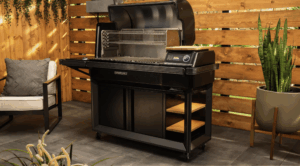
What about customer service and support for each brand? Traeger has a large support team and resources. They offer 7-day a week customer support, and their website has lots of guides, FAQs, and even a Grill Guide app feature to help you troubleshoot or get cooking tips. They also have a huge community, so getting help or replacement parts (even out of warranty) is usually straightforward. Pit Boss being a value brand doesn’t mean skimping on support – they have support lines and online help as well. Many users report Pit Boss is responsive in sending out replacement parts if something arrives damaged or fails under warranty. Pit Boss also has a strong Facebook group community. Overall, you’ll likely get good support from both. Traeger might feel more “white glove” just due to their approach, whereas Pit Boss might require a bit more owner initiative (like sometimes you may fix a small issue yourself with a part they send). Neither will leave you hanging if you reach out for help.
Which pellet grill is better for beginners? Both are friendly to beginners, but I’d say Traeger is almost foolproof for a first-timer. The combination of the Traeger app (with recipes that can control the grill) and the consistent performance means even if you have zero experience, you can produce great results by following Traeger’s guidance. Pit Boss is also easy to use, but you might need to rely on your own recipes or general pellet grill know-how a bit more (which is not hard to learn). If you have a friend or community to guide you, a Pit Boss can be just as rewarding on your maiden voyage. Some beginners choose Pit Boss to start because of the lower cost – and they do just fine. But if you’re nervous and want a very guided experience, Traeger’s ecosystem gives a slight edge for newbies. On the flip side, if you start on a Pit Boss, you’ll learn the basics quickly and might become a well-rounded pitmaster in no time!
Do I need WiFi on my pellet grill? Not necessarily, but it’s a nice convenience. WiFi allows you to monitor and change your grill while you’re away – say you’re watching the game inside and want to check the meat temp on your phone, or you run to the store and still see grill notifications. If you like tech, you’ll enjoy it. If you’re home during most cooks, you might find you don’t actually adjust things remotely that often (after all, pellet grills don’t require much attention anyway once running). I find the best part of WiFi control is monitoring the meat probe – knowing the exact internal temp without opening the lid is great. Also, being able to shut down or lower the temp if you’re stuck in traffic is a potential benefit. Traeger’s WiFi (WiFIRE) is very reliable and has more features (like cook programs) than Pit Boss’s app, but both let you do the basics. If you’re not a smartphone person or you plan to tend the grill manually, you could save money with a non-WiFi model. But given many Pit Boss and Traeger models include WiFi now by default, you’ll probably end up with it. Think of it as a “nice to have, but not must-have” for everyone. People made amazing BBQ for millennia without wireless internet, after all!
Hopefully these FAQs clear up some burning questions. If you’re still undecided or want more info, check out the next sections for further resources.
Final Thoughts
At the end of the day, comparing Pit Boss vs Traeger is like comparing two all-star players with different strengths. Pit Boss grills deliver outstanding value, huge cooking capacity, and that satisfying feeling that you got more than what you paid for. Traeger grills offer a premium, user-friendly experience with top-notch build and tech that make your cooking as effortless as possible. As a grilling dad, I appreciate what both bring to the table: my Pit Boss can sear a mean steak and feed the whole block party, while my Traeger makes overnight brisket as easy as setting a thermostat.
Neither choice is wrong – it’s about finding the grill that fits your needs and budget. Think about how techy you want to get, how much space you need, and how much coin you’re ready to drop on this grilling hobby (warning: it’s addicting!). Whichever brand you choose, you’ll be joining a passionate community of pellet grillers who enjoy tweaking recipes, sharing triumphs (and occasional fails), and savoring that wood-fired flavor.
So fire up that grill, grab your pellets (don’t forget a cold beverage), and welcome to the pellet grilling family! May your cooks be tasty and your troubleshooting be minimal. Happy grilling!
Further Reading
Interested in learning more and diving deeper into the world of pellet grills and BBQ? Here are some great topics to explore next (each will open a new guide or article for you):
- Best Wood Pellets for Smoking – Whether you’re smoking chicken, salmon or anything else, check out our guide to choosing pellet flavors and brands for maximum flavor.
- Pellet Grill Recipes for Beginners – Our smoked mac and cheese, smoked brats and pellet grill pizza are highly rated, and easy to make.
- Gas vs Pellet Grills: Pros and Cons – Compare pellet grilling to traditional gas grilling for your backyard.
Discover more from Own The Grill
Subscribe to get the latest posts sent to your email.


